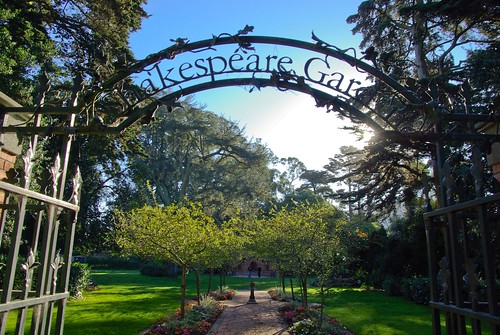

Creating a garden inspired by Shakespeare using plants mentioned in his plays and sonnets is an intriguing project. In more than 20 of his works, gardens and plants are often metaphors for life, with many important scenes taking place in garden settings. The Bard describes the plants of his world in fresh, pithy and often poignant ways, and his characters are often compared to gardeners.
Aristocratic Elizabethan gardens were usually formal in design, with geometrically shaped planting beds laid out symmetrically. The overall shape of the garden might be a large square subdivided into quadrants. Focal points were created with sculptural elements like sundials, stone urns, fountains and statues placed at the end of a central axis or in the center of a planting area. Hedges, fences and stone walls enclosed garden areas and kept livestock away. Well-placed benches provided seating while allées of clipped trees gave much-needed shade and privacy. Espaliered fruit trees were formal and decorative as well as edible.
Today, a Shakespeare garden might include these formal design features as well as plantings in a less formal cottage and herb garden style. Elements of the English countryside such as woodlands, meadows and hedgerows might also be incorporated. The plant palette for all these areas would be chosen from the hundreds of plants mentioned and described in the plays and sonnets.
A decorative hedge or stone or brick wall might define the garden. Geometric planting beds could be symmetrically placed around a central feature or along a central axis. Shade-providing fruit trees might fill the corners of the design. At each entrance, there might be gates with arbors overhead draped with roses or other vines. The view through the arbors might be of a meadow or woodland garden. Beds within the garden could even be devoted to the plants mentioned in individual plays.
Surrounding hedges could be boxwood, yew, or closely spaced trees such as pleached linden or hawthorn. Espaliered roses and fruit trees might be trained along a sheltering brick wall. Herb gardens could include a useful and fragrant mix of medicinal and kitchen herbs like parsley, chamomile, caraway, fennel, lavender and rosemary. Accents coud be pyramidal evergreen shrubs such as English holly (Ilex aquifolium), the more modern Meserve holly (Ilex x merserveae) or English yew (Taxus baccata). Planting beds might contain a mix of flowering annuals, biennials and herbaceous perennials such as pansies (Viola), foxgloves (Digitalis), monkshood (Aconitum) and many others. Spring-flowering hyacinth (Hyacinthoides) and fritillaries (Fritillaria). Climbing and shrub roses would grace arbor entrances and formal beds while small shrubs such as lavender-cotton (Santolina) and germander (Teucrium) might edge the smaller flower and herb beds.
